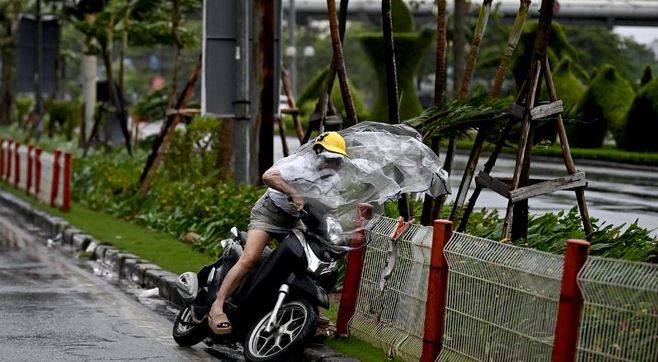Super Typhoon Yagi, Asia’s strongest storm of the year, made landfall in northern Vietnam on Saturday, according to the meteorological agency. The storm struck the Hai Phong and Quang Ninh provinces, packing winds exceeding 149 km/h (92 mph), following its destructive path through southern China’s Hainan island, where it claimed two lives and left dozens injured.
In Hai Phong, metal roofing and commercial signs were seen flying through the sky as residents sheltered from the typhoon’s force. “It’s been years since I witnessed a typhoon this strong,” said Tran Thi Hoa, a local resident. “The sound of the wind and rain was terrifying.”
The typhoon, which brought winds as strong as 230 km/h (143 mph) to China, uprooted trees and prompted the evacuation of 460,000 people on Hainan island. Over 800,000 homes lost power, and streets were flooded as the storm ravaged the region.
Yagi weakened slightly as it moved toward Vietnam, generating winds of up to 160 km/h (99 mph) when it made landfall at around 1 p.m. local time. The industrial city of Hai Phong, home to over two million people, was among the hardest hit. Buildings suffered smashed windows, trees were uprooted, and parts of the city experienced power outages.
Authorities urged residents to stay indoors as the storm battered northern Vietnam. Streets were deserted, and damage reports are still being assessed.
Yagi’s arrival marks another powerful storm in a region frequently impacted by typhoons, which are now intensifying faster and staying over land longer due to climate change, according to recent studies.
Key Points:
Super Typhoon Yagi Makes Landfall: Typhoon Yagi, the most powerful storm in Asia this year, hit northern Vietnam’s Hai Phong and Quang Ninh provinces with winds over 149 km/h (92 mph).
Destruction in Southern China: Prior to reaching Vietnam, Yagi tore through China’s Hainan island, killing two people, injuring dozens, and causing widespread power outages and evacuations.
Hai Phong Hardest Hit: Vietnam’s coastal industrial hub, Hai Phong, experienced significant damage with flying debris, power outages, and shattered windows.
Evacuations and Power Outages: Over 460,000 people were evacuated in China, and more than 800,000 homes lost power as the storm ravaged Hainan.
Climate Change Intensifying Typhoons: Recent studies indicate that typhoons in the region are forming closer to the coast, intensifying more rapidly, and lingering longer due to climate change.
Authorities Urge Caution: Vietnamese authorities called on residents to stay indoors as the storm’s impact continued to unfold, with streets in affected cities left deserted.



